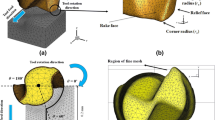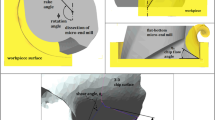Abstract
Predictive models for machining operations have been significantly improved through numerous methods in recent decades. This study proposed a 3D finite element modeling (3D FEM) approach for the micro end-milling of Al6061-T6. Finite element (FE) simulations were performed under different cutting conditions to obtain realistic numerical predictions of chip flow, burr formation, and cutting forces. FE modeling displayed notable advantages, such as capability to easily handle any type of tool geometry and any side effect on chip formation, including thermal aspect and material property changes. The proposed 3D FE model considers the effects of mill helix angle and cutting edge radius on the chip. The prediction capability of the FE model was validated by comparing numerical model and experimental test results. Burr dimension trends were correlated with force profile shapes. However, the FE predictions overestimated the real force magnitude. This overestimation indicates that the model requires further development.
Similar content being viewed by others
References
Li H, Lai X, Li C, et al. Development of meso-scale milling machine tool and its performance analysis. Frontiers of Mechanical Engineering in China, 2008, 3(1): 59–65
Masuzawa T. State of the art of micromachining. CIRP Annals —Manufacturing Technology, 2000, 49(2): 473–488
Liu X, DeVor R E, Kapoor S G. An analytical model for the prediction of minimum chip thickness in micromachining. Journal of Manufacturing Science and Engineering, 2005, 128(2): 474–481
Bao W Y, Tansel I N. Modeling micro-end-milling operations. Part I: Analytical cutting force model. International Journal of Machine Tools and Manufacture, 2000, 40(15): 2155–2173
Arrazola P J, Özel T, Umbrello D, et al. Recent advances in modelling of metal machining processes. CIRP Annals—Manufacturing Technology, 2013, 62(2): 695–718
Maurel-Pantel A, Fontaine M, Thibaud S, et al. 3D FEM simulations of shoulder milling operations on a 304L stainless steel. Simulation Modelling Practice and Theory, 2012, 22(3): 13–27
Rubio L, De la Sen M, Longstaff A P, et al. Analysis of discrete time schemes for milling forces control under fractional order holds. International Journal of Precision Engineering and Manufacturing, 2013, 14(5): 735–744
Özel T, Altan T. Modeling of high speed machining processes for predicting tool forces, stresses and temperatures using FEM simulations. In: Proceedings of the CIRP International Workshop on Modeling of Machining Operations. Atlanta, 1998
Özel T, Altan T. Process simulation using finite element method prediction of cutting forces, tool stresses and temperatures in highspeed flat end milling. International Journal of Machine Tools and Manufacture, 2000, 40(5): 713–738
Liu K, Melkote S N. Finite element analysis of the influence of tool edge radius on size effect in orthogonal micro-cutting process. International Journal of Mechanical Sciences, 2007, 49(5): 650–660
Nasr M N A, Ng E G, Elbestawi M A. Modelling the effects of tooledge radius on residual stresses when orthogonal cutting AISI 316L. International Journal of Machine Tools and Manufacture, 2007, 47 (2): 401–411
Afazov S M, Ratchev S M, Segal J. Modelling and simulation of micro-milling cutting forces. Journal of Materials Processing Technology, 2010, 210(15): 2154–2162
Özel T, Liu X, Dhanorker A. Modelling and simulation of micromilling process. In: Proceedings of the 4th International Conference and Exhibition on Design and Production of Machines and Dies/Molds. 2007
Jin X, Altintas Y. Prediction of micro-milling forces with finite element method. Journal of Materials Processing Technology, 2012, 212(3): 542–552
Thepsonthi T, Özel T. Experimental and finite element simulation based investigations on micro-milling Ti-6Al-4V titanium alloy: Effects of cBN coating on tool wear. Journal of Materials Processing Technology, 2013, 213(4): 532–542
Woon K S, Rahman M, Neo K S, et al. The effect of tool edge radius on the contact phenomenon of tool-based micromachining. International Journal of Machine Tools and Manufacture, 2008, 48(12–13): 1395–1407
Wu H, Zhang S. 3D FEM simulation of milling process for titanium alloy Ti6Al4V. International Journal of Advanced Manufacturing Technology, 2014, 71(5–8): 1319–1326
Yang K, Liang Y, Zheng K, et al. Tool edge radius effect on cutting temperature in micro-end-milling process. International Journal of Advanced Manufacturing Technology, 2011, 52(9–12): 905–912
Thepsonthi T, Özel T. 3-D finite element process simulation of micro-end milling Ti-6Al-4V titanium alloy: Experimental validations on chip flow and tool wear. Journal of Materials Processing Technology, 2015, 221: 128–145
Chen, M, Ni H, Wang Z, et al. Research on the modeling of burr formation process in micro-ball end milling operation on Ti-6Al-4V. International Journal of Advanced Manufacturing Technology, 2012, 62(9): 901–912
Advantedge TW. User manual for ThirdWave AdvantEdge Version 6.2.011, USA
Man X, Ren D, Usui S, et al. Validation of finite element cutting force prediction for end milling. Procedia CIRP, 2012, 1: 663–668
Davoudinejad A, Chiappini E, Tirelli S, et al. Finite element simulation and validation of chip formation and cutting force in dry and cryogenic cutting of Ti-6Al-4V. Procedia Manufacturing, 2015, 1: 728–739
Arrazola P J, Özel T. Investigations on the effects of friction modeling in finite element simulation of machining. International Journal of Mechanical Sciences, 2010, 52(1): 31–42
Özel T. The influence of friction models on finite element simulations of machining. International Journal of Machine Tools and Manufacture, 2006, 46(5): 518–530
Kim K W, Lee W Y, Sin H C. A finite element analysis for the characteristics of temperature and stress in micro-machining considering the size effect. International Journal of Machine Tools and Manufacture, 1999, 39(9): 1507–1524
Al-Qutub A M, Khalil A, Saheb N, et al. Wear and friction behavior of Al6061 alloy reinforced with carbon nanotubes. Wear, 2013, 297 (1–2): 752–761
Bathurst S P, Kim S G. Designing direct printing process for improved piezoelectric micro-devices. CIRP Annals—Manufacturing Technology, 2009, 58(1): 193–196
Annoni M, Pusterla N, Rebaioli L, et al. Calibration and validation of a mechanistic micromilling force prediction model. Journal of Manufacturing Science and Engineering, 2015, 138(1): 011001
Hashimura M, Hassamontr J, Dornfeld D A. Effect of in-plane exit angle and rake angles on burr height and thickness in face milling operation. Journal of Manufacturing Science and Engineering, 1999, 121(1): 13–19
Davoudinejad A. 3D finite element modeling of micro end-milling by considering tool run-out, temperature distribution, chip and burr formation. Dissertation for the Doctoral Degree. Milan: Polytechnic University of Milan, 2016
Johnson G R, Cook W H. A constitutive model and data for metals subjected to large strains, high strain rates and high temperatures. In: Proceedings of the 7th International Symposium on Ballistics. The Hague, 1983, 541–547
Calamaz M, Coupard D, Girot F. A new material model for 2D numerical simulation of serrated chip formation when machining titanium alloy Ti-6Al-4V. International Journal of Machine Tools and Manufacture, 2008, 48(3–4): 275–288
Author information
Authors and Affiliations
Corresponding author
Rights and permissions
About this article
Cite this article
Davoudinejad, A., Parenti, P. & Annoni, M. 3D finite element prediction of chip flow, burr formation, and cutting forces in micro end-milling of aluminum 6061-T6. Front. Mech. Eng. 12, 203–214 (2017). https://doi.org/10.1007/s11465-017-0421-6
Received:
Accepted:
Published:
Issue Date:
DOI: https://doi.org/10.1007/s11465-017-0421-6




